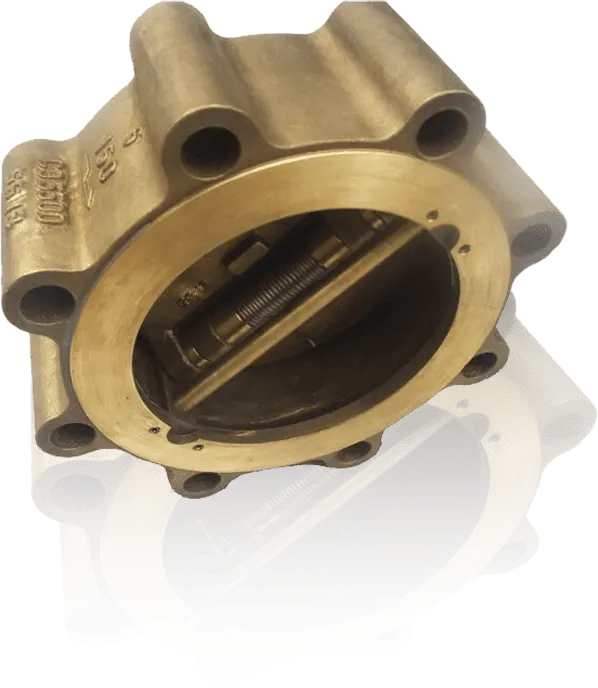In industrial pipeline systems, check valves play a crucial role in preventing backflow, protecting equipment, and ensuring the safe operation of the system. The wafer check valve stands out in various applications due to its compact design, lightweight construction, and reliable performance.

Basic Structure of Wafer Check Valve
The wafer check valve is a type of one-way valve designed for wafer-style installation. It consists of several key components, including the valve body, disc, spring, hinge pin, and sealing elements:
1. Valve Body
Typically made from stainless steel, carbon steel, or other corrosion-resistant materials, providing excellent strength and durability.
2. Disc
The core component responsible for opening and closing the flow path, commonly designed as a single disc or dual-disc configuration
3. Spring
Provides the restoring force to ensure the disc closes promptly when the fluid stops or flows backward.
4. Sealing Elements
Enhance sealing performance and minimize the risk of leakage.
Its compact design allows the valve to be clamped directly between flanges without the need for additional support structures, significantly reducing installation space and overall weight.
Working Principle: Efficient One-Way Flow Control
The operation of a wafer check valve is based on the interplay between fluid pressure and spring force:
1. Forward Flow
When the medium enters the valve inlet, the fluid pressure overcomes the spring force, pushing the valve disc open and allowing the medium to flow through the valve smoothly. At this stage, resistance is minimal, and flow loss is negligible.
2. Flow Stops or Reverses
When the forward flow diminishes or reverse flow occurs, the combined action of the spring force and backflow pressure rapidly closes the valve disc, preventing the medium from flowing backward.
This passive operation requires no external power, providing a high degree of automation. Additionally, it effectively prevents water hammer caused by backflow, thereby protecting the system and its critical components.
Application Scenarios: A Critical Protective Role Across Industries
Wafer check valves are widely used across various industries due to their unique performance and structural design:
1. Pump Protection
Installed at pump outlets, wafer check valves prevent reverse flow when the pump is stopped, avoiding impact damage to impellers and internal components. This is particularly crucial in chemical and water supply systems.
2. Liquid Transmission Pipelines
Used to prevent contamination caused by liquid backflow, they are commonly found in the food, pharmaceutical, and water treatment industries.
3. Oil and Gas
In long-distance pipeline transportation, wafer check valves prevent backflow that can cause system pressure fluctuations, protecting downstream equipment.
4. High-Rise Building Water Supply
Ensures unidirectional flow between floors, reducing pressure fluctuations in the supply system that could damage pipes and valves.
Application Selection for Different Types of Wafer Check Valves
Wafer check valves can be categorized into dual-plate and single-plate types based on their structure. Each type has distinct characteristics and is suited to specific applications:
1. Single-Plate Type Wafer Check Valves
Ideal for small-diameter pipelines, featuring a simple structure but higher fluid resistance.
2. Dual-Plate Type Wafer Check Valves
The most widely used design, offering low fluid resistance. It is suitable for medium to large-diameter pipelines and is the preferred choice for standard industrial applications.
Advantages and Limitations of Wafer Check Valves
Advantages
1. Compact Structure
The wafer-type design ensures minimal space requirement during installation, making it ideal for equipment-dense factories and high-rise buildings.
2. Lightweight
Compared to traditional flanged check valves, its lightweight construction reduces the load on the pipeline system.
3. Efficient Performance
The automatic closing mechanism and low fluid resistance make it highly effective in systems with frequent opening and closing cycles.
4. Easy Installation
Requires no additional support or complex connections, allowing quick installation between two flanges
Limitations
1. Inadequate Low-Pressure Sealing
Its sealing performance may fall short in low-pressure or vacuum conditions compared to fully enclosed check valves.
2. Limited Medium Applicability
Not suitable for media containing particles or with high viscosity, as these could cause wear or jamming of the valve disc.
Conclusion
Wafer check valves are essential for preventing backflow and protecting equipment in industrial pipelines. Their compact, lightweight design allows for easy flange installation, minimizing space and weight. Operating automatically, they ensure one-way flow without external power.
Used across industries such as chemical, water supply, and oil and gas, they prevent backflow and protect systems like pumps. Available in dual-plate and single-plate types, they suit various pipeline sizes.
While efficient and easy to install, wafer check valves may struggle with low-pressure or high-viscosity media. Despite this, their reliability makes them vital for many industrial applications.
Previous: What is the Purpose of a Pump Strainer?
